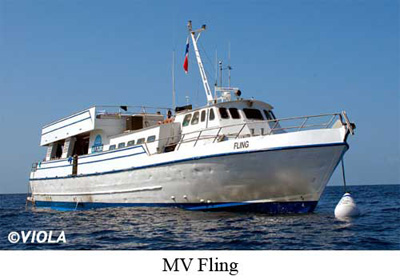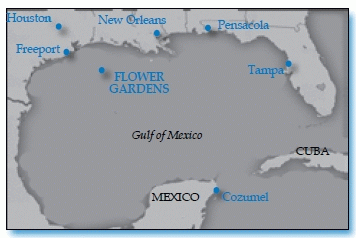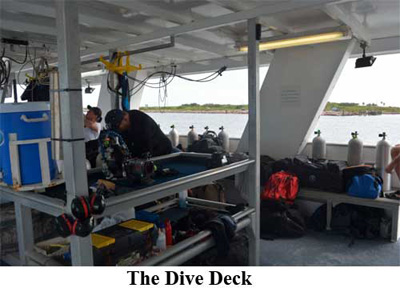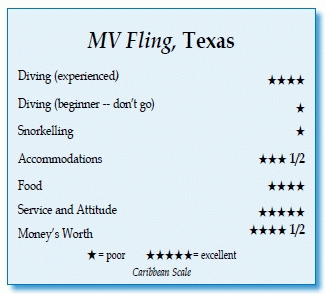MV Fling, Flower Gardens, TexasContents of this Issue: MV Fling, Flower Gardens, Texas Ocean Hunter III, Palau, Micronesia “Both Divers Resisted the Natural Instincts of Self-Preservation” A “Too Exclusive” Island in Indonesia Hawaii Snorkeler Dies in Rough Water Readers’ Letters: Bends, Photographers and Scaring Sharks Editorial Office: Ben Davison Publisher and Editor Undercurrent 3020 Bridgeway, Suite 102 Sausalito, CA 94965 seven dives in 27 hours for just $645 from the September, 2014 issue of Undercurrent
Dear Fellow Diver: Ah, Texas -- oil wells, armadillos, Tex-Mex food, cowboys and coral reefs. Yes, coral reefs. The Texas coast starts at Louisiana and curves around to Mexico, and while there are fine beaches, this is not a destination for shore divers. To get to the best diving, you must do as I did the first week of August, and travel 111 miles east/southeast to the Flower Gardens National Marine Sanctuary, which comprises three separate reef systems -- East and West Flower Gardens, and Stetson Bank.
At 7:45, the staff briefed us on procedures, then opened the gates. We veterans (I made this trip last year) took off in a speed walk to claim bunks,while the newbies stood there wondering what the hell was going on. The preferred spots are below decks -- six four-bunk cabins, with the bunks curtained off from each other (four additional bunks are tucked under the ladder to the main deck, and two more are forward). After claiming a cabin and stowing gear, I headed up to the main deck, where divers were congregating in the large, air-conditioned galley/dining room. Three large tables with two benches run along the port side (each bench handles four nicely), and on the starboard side is a table for four and the galley. JT, a good-humored, bald fellow in his 30s who has been a Fling divemaster for several years, presented our safety and procedural briefing. One rule: No throwing up in the head. Everyone was issued a DRCD (Disposable Regurgitation Containment Device) -- i.e., a trash bag -- and instructed to "fluff" it out so that it was ready at a moment's notice. Then out came chicken wings, cheese, crackers, celery and carrots, as the Fling cleared the channel and headed out. At 10 p.m., I hit the sack.
After a buddy check, my group of four made our way to the amidships' entry point on the back deck (there's one port and one starboard). I gave my bunk number -- that's how divers are tracked -- to the divemaster, and with a giant stride, I dropped five feet into the 85-degree blue water. I met my buddies at the anchor line, and down we went. Because both JT and the more reserved Michael, the second divemaster, remain on the deck during dives, Fling divers need to know what they are doing. At the 90-foot bottom, the water dropped to 78 degrees, and there I was, diving on a Texas coral reef. It's mainly brain coral heads and fingers -- there are more than 20 species of coral -- with sand patches. However, something seemed different from last year. Maybe I had been easily impressed then, but this time the fish were fewer and the scene duller, though the visibility was 90 feet. Regardless, if Cozumel were rated 10, this was a strong 7 -- and it's in Texas! The current, though strong at the surface, calmed down. Our buddy plan, which JT had suggested in the briefing, was to kick into the current, swim in a large circle, eventually return to the mooring line with the current at our backs, and then finish with a 15-foot safety stop on hanging lines. In and around the coral heads, I found queen, French and juvenile angels, soldierfish, neon wrasse, butterflyfish, parrots, jacks, morays and plenty of barracuda. Here and there, stingrays were buried in the sand. Indeed, a good variety of fish, but not the quantities that I remembered from last year. Unfortunately, lionfish were large and abundant, and their unseemly predation may be affecting the fish population. Because spearfishing is prohibited in the sanctuary, can Flower Gardens still be considered a sanctuary, having been occupied by an army of invaders? Should not the regulations be eased to control this nasty predator?
After a 10:30 a.m. dive at the same spot but in a different direction, I surfaced past 15 or so barracuda hanging under the boat, and climbed aboard, where the crew greeted me by name. "Hi, Jack, how was your dive?" "Nice, thanks." Then it was grilled-cheese sandwiches, homemade soup, chips, veggies and cake for dessert. Dive, eat, rest, dive, eat, rest dive, eat, rest -- see a pattern developing here? Next up was an offshore oil rig in 300 feet of water, though the Captain claimed the bottom was now only 250 feet down because, he figured, 50 feet of lost gear has piled up over the years from negligent divers. Make sure your gear is secure, he cautioned, because nothing dropped will be recovered. The crew tied off a line at 45 feet on the rig, which I followed down to dive inside the structure, covered with soft coral, barnacles and other growth. It was fish city. Queen and juvenile angels, squirrelfish, butterflies, horse-eyed jacks, barracuda, snapper, tangs and, 40 feet below me, sharks -- silky, white-tip and black-tip -- circled the rig. As I watched them, I was stunned to see an enormous 20-foot whale shark swim within 20 feet of the rig. It made a slow circle, then two more, each time moving farther out. Of course, I had the wrong lens -- how embarrassing that later I had to beg my buddy for copies of his shots. Late in the afternoon, we arrived at the East Flower Garden Reef. The sun was well past ideal for penetrating light. The dive was similar to those on West Flower Gardens Reef, and I logged 47 minutes, with 450 psi left in my tank. After four dives, I was ready for dinner -- the Saturday night barbequed brisket, one meal that is famous among Fling divers. When I arrived in the dining salon, however, something was missing. Where was that grand brisket aroma? The potato salad, beans, hot bread and relishes were ready, but chefs Scott and John were huddled around the oven and not looking happy. Turned out the generator went down, and though it was up and running quickly, the ovens had dumped the cooking program and stopped operating. I soon learned that you could put half-done brisket slices in frying pans, add some broth and barbecue sauce, and produce some mighty fine brisket in no time. Some folks had sodas or beers ($3 and sold until midnight), and I spotted a few flasks coming out to flavor the Coke. Of course, when the drinking starts, the diving stops, so -- presumably -- there was no night dive for the tipplers.
A word about the bunks. They're standard crew boat bunks, plywood construction, each with a foam mattress, clean sheets, pillows, pillowcases, and a blanket. Comfortable unless you like to sprawl out. It takes a little time to learn how to roll in and out of the bottom bunk, and there's not enough room to sit up. Each bunk has its own light, and curtains slide on a wire to offer privacy. If you need to hit the head at night, you get up in the dark and make your way to the ladder to the heads on the main deck. In the morning at Stetson Bank, 29 miles northwest of the Flower Gardens, we made our last two dives. Before the 7 a.m. dive, the crew checked conditions and laid a bottom line against the slight current to the edge of the reef. Follow the line to the wall, they said, go right or left until you reach your turnaround time based on tank pressure, then return along the wall to the line and the mooring. My three buddies know I shoot lot of pictures, so they moved slowly and pointed out critters for me -- they're used to having the old man with the camera behind them. A squirrelfish lying next to a white-andblack sea urchin made a good shot, then a trio of juvenile angelfish, then a gray angel, then a queen, then . . . I was down 40 minutes and I hadn't traveled halfway along the line before I needed to turn back. Diving again after another Texas-sized breakfast, I made it to the edge of the reef, with my camera firing like a machine gun. Butterflyfish were swimming in pairs, a trio of soldierfish posed nicely. Queen angels darted in and out of the wall. A threefoot moray swam past. The wall was small, maybe 15 to 20 feet before it turned into a sloping sand bottom, but it offered plenty of fish to photograph. I wish the majority of the Fling's dives were on Stetson Bank. After seven dives in 27 hours, I was tired, but also sad we were headed back, happy that I took a lot of good fish shots, and thankful that there wasn't a single incident during the trip. Oh, and hungry again. So, it was a hearty lunch of lasagna, with plenty of time during the six-hour run back to pack my gear and catch a last nap. While heading home, the crew opened the company store. Funny how beer sales really picked up at the end of dive number seven. Once home, I let the trip settle in. Yes, I was there last August. And this year too. And no doubt I'll be there next year. Having had the opportunity to dive all over the world, I would say that is a damn good endorsement for coral reefs so close to home. -- J.P.W.
|

I want to get all the stories! Tell me how I can become an Undercurrent Online Member and get online access to all the articles of Undercurrent as well as thousands of first hand reports on dive operations world-wide
| Home | Online Members Area | My Account |
Login
|
Join
|
| Travel Index |
Dive Resort & Liveaboard Reviews
|
Featured Reports
|
Recent
Issues
|
Back Issues
|
|
Dive Gear
Index
|
Health/Safety Index
|
Environment & Misc.
Index
|
Seasonal Planner
|
Blogs
|
Free Articles
|
Book Picks
|
News
|
|
Special Offers
|
RSS
|
FAQ
|
About Us
|
Contact Us
|
Links
|
3020 Bridgeway, Ste 102, Sausalito, Ca 94965
All rights reserved.

 The MV Fling is no Damai, Dancer or Aggressor, but
the Gulf of Mexico is no Red Sea, either. Docked in
Freeport, TX, about 60 miles south of Houston, she is
a 100-foot-long, 22-foot-wide converted crew ship, powered
by three 600-hp diesel engines and set up to carry
28 divers and crew. There is a double bed forward, so if
a couple shares it, the Fling can handle 30, as was the
case on my trip. Because bunk space is first-come, firstserve,
my three buddies and I arrived several hours before
the 8 p.m. boarding time. After staking my place in line
with my gear (they provide tanks and weights), we headed
for the On the River restaurant and some great Gulf Coast
seafood. Then, back to the line, but only after slathering
myself with mosquito
repellant. In
the harbor at sundown,
the Texas-sized
saltwater mosquitoes
are vicious.
The MV Fling is no Damai, Dancer or Aggressor, but
the Gulf of Mexico is no Red Sea, either. Docked in
Freeport, TX, about 60 miles south of Houston, she is
a 100-foot-long, 22-foot-wide converted crew ship, powered
by three 600-hp diesel engines and set up to carry
28 divers and crew. There is a double bed forward, so if
a couple shares it, the Fling can handle 30, as was the
case on my trip. Because bunk space is first-come, firstserve,
my three buddies and I arrived several hours before
the 8 p.m. boarding time. After staking my place in line
with my gear (they provide tanks and weights), we headed
for the On the River restaurant and some great Gulf Coast
seafood. Then, back to the line, but only after slathering
myself with mosquito
repellant. In
the harbor at sundown,
the Texas-sized
saltwater mosquitoes
are vicious. About 6 a.m., somewhere in that semi-conscious world of a great sleep
induced by droning engines and a rocking boat, I heard the engines shut down.
Then at 6:15 came a knock on the cabin door. After fresh fruit, hot cinnamon
rolls, coffee and juice, I joined others on the rear deck for a briefing on the
West Flower Gardens. JT, who had already been in the water, described the currents
and what he saw in the way of marine life. Nitrox divers were told to confirm
the 32-percent oxygen mix with an analyzer the crew would provide, then
record the mix, the maximum depth allowable for the mix, their tanks' serial
numbers, and then sign the book. Penny, the petite deckhand appearing to be
in her mid-30s, worked like crazy to see that all 30 tanks, which were lined
up behind the roomy bench seats, were promptly filled between dives (she also
joined every dive).
About 6 a.m., somewhere in that semi-conscious world of a great sleep
induced by droning engines and a rocking boat, I heard the engines shut down.
Then at 6:15 came a knock on the cabin door. After fresh fruit, hot cinnamon
rolls, coffee and juice, I joined others on the rear deck for a briefing on the
West Flower Gardens. JT, who had already been in the water, described the currents
and what he saw in the way of marine life. Nitrox divers were told to confirm
the 32-percent oxygen mix with an analyzer the crew would provide, then
record the mix, the maximum depth allowable for the mix, their tanks' serial
numbers, and then sign the book. Penny, the petite deckhand appearing to be
in her mid-30s, worked like crazy to see that all 30 tanks, which were lined
up behind the roomy bench seats, were promptly filled between dives (she also
joined every dive). When I returned to the boat, getting on board was quick and efficient.
I hooked my housed Nikon D7100 on a special line and a crew member hauled
it onboard. I grabbed a floating line to pull myself in, removed my fins and
climbed the stern ladder to the swim platform. I was asked for my number, plus
my dive time and depth, which a crew member recorded. Up three more steps to
the aft deck for a freshwater rinse, then off came my gear. Inside the head
in the main deck/galley area (the Fling has three heads, and waits were always
short), I pulled on dry shorts. Then a Texas breakfast of biscuits, gravy, eggs,
and toast -- not fancy, but down-home good and plenty of it. Afterwards, with a
couple of hours to kill, I took a short snooze on my bunk. Other times, I headed
to the spacious sun deck (lounge and beanbag chairs, and tables with seats)
to schmooze with some of the 20 other guys and nine women aboard. In the main
cabin, some divers watched videos while others edited their photos on laptops.
When I returned to the boat, getting on board was quick and efficient.
I hooked my housed Nikon D7100 on a special line and a crew member hauled
it onboard. I grabbed a floating line to pull myself in, removed my fins and
climbed the stern ladder to the swim platform. I was asked for my number, plus
my dive time and depth, which a crew member recorded. Up three more steps to
the aft deck for a freshwater rinse, then off came my gear. Inside the head
in the main deck/galley area (the Fling has three heads, and waits were always
short), I pulled on dry shorts. Then a Texas breakfast of biscuits, gravy, eggs,
and toast -- not fancy, but down-home good and plenty of it. Afterwards, with a
couple of hours to kill, I took a short snooze on my bunk. Other times, I headed
to the spacious sun deck (lounge and beanbag chairs, and tables with seats)
to schmooze with some of the 20 other guys and nine women aboard. In the main
cabin, some divers watched videos while others edited their photos on laptops. For that 9 p.m. night dive, the crew attached several strobes to lines.
Each diver was required to have his own light, and each buddy team a backup.
Furthermore, tank lights were required (cyalume sticks were available from the
boat's store). Underwater, the activity was again lacking, though the corals were
out, as were a new set of players -- a barren circular sand patch I had passed
over on the previous dive was now a cleaning station, with barracuda waiting to
have their teeth and gills picked free of critters. I grabbed a couple of shots
of a four-foot moray cutting in and out of the coral. Back on board and after
showering, I polished off hot brownies and Blue Bell ice cream, and headed to my
bunk. The last thing I heard was the engines firing up as the Fling prepared to
move to the next morning's dive site.
For that 9 p.m. night dive, the crew attached several strobes to lines.
Each diver was required to have his own light, and each buddy team a backup.
Furthermore, tank lights were required (cyalume sticks were available from the
boat's store). Underwater, the activity was again lacking, though the corals were
out, as were a new set of players -- a barren circular sand patch I had passed
over on the previous dive was now a cleaning station, with barracuda waiting to
have their teeth and gills picked free of critters. I grabbed a couple of shots
of a four-foot moray cutting in and out of the coral. Back on board and after
showering, I polished off hot brownies and Blue Bell ice cream, and headed to my
bunk. The last thing I heard was the engines firing up as the Fling prepared to
move to the next morning's dive site. Divers Compass: At $645 for seven nitrox dives, two nights and
eight meals, the price is right . . . All trips are booked
through dive shops, or you can call (979)233-4445 . . . A 10-
to 15-percent cash deposit in the tip bucket was about normal;
all tips are split evenly among the crew . . . As soon as the
Fling arrives in port, between 5 and 5:30 p.m., she is fueled,
cleaned, provisioned, reloaded and then heads back out; occasionally
there are longer trips, but typically the two-night
trips are Wednesday-Friday and Friday-Sunday, with three-night
trips Sunday-Wednesday . . . Should a trip be canceled for weather or any
other reason, your money is refunded . . . The average age on this trip was
considerably younger (mid-30s or so, with one diver on my last trip just 15
years old) than it would be, say, on an Aggressor . . . Nitrox certification
is essential for decent bottom times . . . Though seas were calm during
the first week of August, if you're prone to seasickness, bring your preferred
seasick remedy so you can take home an empty DRCD . . . The Fling's store
sells caps, T-shirts, etc., but there is no rental gear, so bring everything
you need, including save-a-dive kits . . . Website:
Divers Compass: At $645 for seven nitrox dives, two nights and
eight meals, the price is right . . . All trips are booked
through dive shops, or you can call (979)233-4445 . . . A 10-
to 15-percent cash deposit in the tip bucket was about normal;
all tips are split evenly among the crew . . . As soon as the
Fling arrives in port, between 5 and 5:30 p.m., she is fueled,
cleaned, provisioned, reloaded and then heads back out; occasionally
there are longer trips, but typically the two-night
trips are Wednesday-Friday and Friday-Sunday, with three-night
trips Sunday-Wednesday . . . Should a trip be canceled for weather or any
other reason, your money is refunded . . . The average age on this trip was
considerably younger (mid-30s or so, with one diver on my last trip just 15
years old) than it would be, say, on an Aggressor . . . Nitrox certification
is essential for decent bottom times . . . Though seas were calm during
the first week of August, if you're prone to seasickness, bring your preferred
seasick remedy so you can take home an empty DRCD . . . The Fling's store
sells caps, T-shirts, etc., but there is no rental gear, so bring everything
you need, including save-a-dive kits . . . Website: 